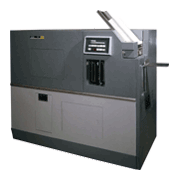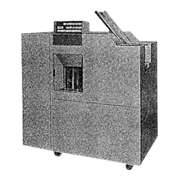Fujitsu conducted its own technology development for computer peripheral equipment, and created a line of peripherals based on its own technology at the time of the FACOM 222. Around 1961, they completed a line of card units for the large FACOM 222 machines: the FACOM 661 and FACOM 663 card readers, the FACOM 681 and FACOM 682 card punches, and the FACOM 701 and FACOM 702 card reader/punches (which read information on cards, sent the information to the computer, and then punched information from the computer on the same card). These units had the following features:
(1) They employed 80-column and 90-column IBM cards (Units for 90-column cards had an "R" suffix on the model name).
(2) They were high-speed.
They featured high-speed rivaling that of the leading foreign manufacturers. More specifically, they used pulse motors to achieve a short access time (i.e. the time from when the computer issued an instruction until the card moved).
(3) They were stable and solid.
Reader parts were photoelectric, employing solar batteries, and thus were not susceptible to the brush wear and card damage which plagued brush type readers. They could also read accurately even if there was fluff at the punched hole.
(4) They had a comprehensive check mechanism to prevent input/output of erroneous information.
For the FACOM 222 large computers, the computer and card units were connected via a control unit with a buffer to reduce access time, and for the FACOM 231 and FACOM 241 small computers and the FACOM 230-30 mid-size computers, connection was done via a control unit without a buffer in order to lower the price of the equipment.
The FACOM 664 card reader and the FACOM 683 card punch were developed later, around 1966, by setting aside processing speed, and focusing on better compactness, stability, cost and ease-of-use.
| FACOM 661(R) FACOM 663(R) |
FACOM 681(R) FACOM 682(R) |
FACOM 701(R) FACOM 702(R) |
FACOM 664 |
FACOM 683 |
|
|---|---|---|---|---|---|
| Unit type | Card reader | Card punch | Card reader/punch | Card reader | Card punch |
| Completion date | Around 1961 (Estimated) | Around 1966 (Estimated) | |||
| Primary connected computers | FACOM 222 via control unit with buffer FACOM 231, 241, 230-30 via control unit without buffer | FACOM 230-60, 230-5 Series | |||
| Cards used | 80-column (90-column: Model name suffixed with "R"*1) | 80-column, 90-column | |||
| Read speed*2 (card/min) | F661: F500 F663: F800 |
- | F701: F200 F702: F250 |
570/800 | - |
| Punch speed*2 (card/min) | - | F681: F200 F682: F250 |
F701: F200 F702: F250 |
- | 250 |
| Checks | Card feed Double reading using dual heads | Card feed Correlation with read information after punching | Card feed Double-reading using dual heads Correlation with read information after punching | Card feed Double reading using dual heads | Card feed Correlation with read information after punching |
| Hopper | 2,800card magazine + Hopper (approx. 250 cards) | 3,000card (with file field) | |||
| Stacke | 800card x2 | ||||
| External dimensions (mm) | 1,050(W)x750(D)x1,200(H) | 1,195(W)x750(D)x1,220x(H) | |||
| Weight (kg) | 360 | 540 | 550 | 400 | 600 |
*1:Units for 90-column cards had an "R" suffix on the model name. (Ex. FACOM 661R)
*2:FACOM is abbreviated to F. (Ex. F661 means FACOM 661)



